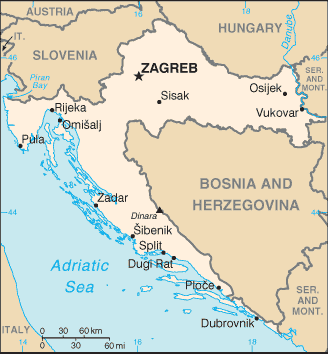Map:

Overview:
The lands that today comprise Croatia were part of the Austro-Hungarian Empire until the close of World War I. In 1918, the Croats, Serbs, and Slovenes formed a kingdom known after 1929 as Yugoslavia. Following World War II, Yugoslavia became a federal independent Communist state under the strong hand of Marshal TITO. Although Croatia declared its independence from Yugoslavia in 1991, it took four years of sporadic, but often bitter, fighting before occupying Serb armies were mostly cleared from Croatian lands. Under UN supervision, the last Serb-held enclave in eastern Slavonia was returned to Croatia in 1998.
The People:
Population: 4,495,904 (July 2005 est.)
Age structure:
0-14 years: 16.4% (male 378,615/female 359,231)
15-64 years: 67% (male 1,497,355/female 1,514,993)
65 years and over: 16.6% (male 283,460/female 462,250) (2005 est.)
Religions:
Roman Catholic 87.8%, Orthodox 4.4%, other Christian 0.4%, Muslim 1.3%, other and unspecified 0.9%, none 5.2% (2001 census)
Government Type:
presidential/parliamentary democracy
Leader(s) to pray for:
chief of state: President Stjepan (Stipe) MESIC (since 18 February 2000)
head of government: Prime Minister Ivo SANADER (since 9 December 2003); Deputy Prime Ministers Jadranka KOSOR (since 23 December 2003) and Damir POLANEC (since NA February 2005)
Source: The World Factbook
View All Countries